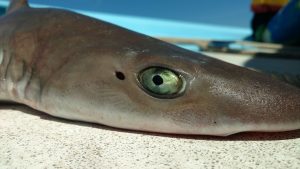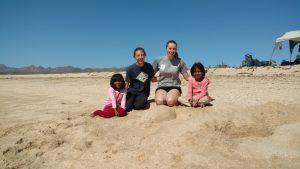Spring semester, junior year, I went to the Marine Lab in Beaufort, NC. This semester was structured as a block schedule so that students could take one or several travel courses. In the last block, I enrolled in the course Community-Based Marine Conservation in the Gulf of California, which included travel to Mexico.
I was very excited for this class after my semester abroad and my growing interest in the topic of community-based environmental management. Before we departed, we read about indigenous culture, local flora and fauna, and Mexican history to build a basic understanding of the community and environment we would be visiting.
The stated goal of this course:
This is an experiential education course designed to allow students to learn first-hand about “community” and “conservation” and how both come together in the context of the marine environment thus “community-based marine conservation.”
Once in Kino Bay, Mexico, we spent nights camping in the desert or on islands in the Gulf of California. We met and interviewed local fishermen, conservation practitioners, and indigenous people both opportunistically and as part of our class schedule. When we weren’t travelling around the region, we were stationed at Prescott College’s Kino Bay Center.
I learned about local community management structures through class lectures as well as interactions with conservation organizers, fish buyers, fishermen, and others involved with the long term protection of marine resources. On camping excursions, we held nightly discussions under the stars to process what we’d seen and experienced during the day. During this time, we also informally told stories and listened to stories told by the Comcáac people camping with us.
- The undergrad tent
- Typical fishing gear
- Small shark caught by community fishermen
- Talking to a fishermen’s son
- Fishermen returning in the morning
- Local fishermen processing shark
- Sunset over the desert
- Playing in the sand with Katie, Valentina, and Kenya
We kept journals about the experience to keep field notes and reflect on what we were learning. Each student picked a topic they were interested in within the context of the course. I chose to interview several Comcáac individuals that joined us on our trip to Tiburón Island in an effort to understand inter-generational differences in indigenous community social structures. I invented my own interview technique using visuals so I could conduct them independently with my limited Spanish.

Interview diagram used for asking Claudia questions
I asked each of my interviewees to fill in the circles with people, places, and things they care about, ordering what is “close to their hearts.” This exercise was followed by pre-written, loose-structured questions about their social media use and news sources. My final report can be read here.
I was inspired to investigate inter-generational differences after listening to Xavier, a Comcáac elder, explain to us old marriage traditions. Earlier in the day, I had talked to a woman in her late 20s about her concept of marriage — which was wildly different than the version Xavier told. I summarized the experience here.
Check out the class blog here!
Course: ENV 528SA
Instructor: Dr. Xavier Basurto
Syllabus for Gulf of California

“Friends without walls” mural outside of Prescott College Kino Bay Center
This course truly solidified my interest in community-based conservation. In both Bhutan and Mexico, I learned about two very different systems of community management of natural resources and conservation, and both drew upon local strengths and knowledge to handle the challenge. This course in particular was helpful in understanding community dynamics and the interplaying scales of governance in the region. Community-based conservation is a real and effective tool to protect nature and its resources for a more sustainable future…













